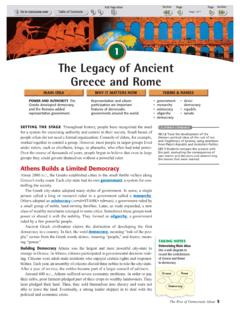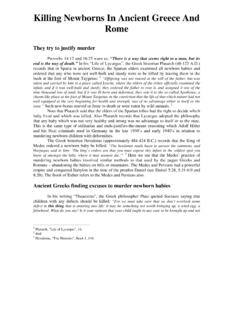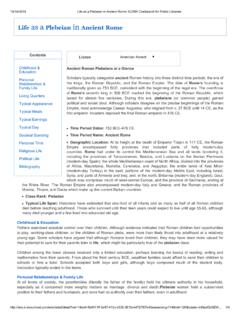Transcription of Childhood in Ancient Rome - Monmouth College
1 Ariel Fornino 2/11/2014 Childhood in Ancient Rome Early Childhood Infant to about 5 years of age 8 days a girl was named and 9 days for boys Children wore a bulla to wear around their neck to void off evil. The naming day was called dies lustricus (Day of Purification). The Child and the Mother were purified during this ceremony. The child was given presents to hang around its neck called crepundia. Marcus Aurelius required a birth registration. He was the first emperor to do so. Middle Childhood 6 years to about 10 years old Elite children wore a toga praetexta Continuously fighting off diseases that ravaged young children. Dolls of various makes were given to them Games were played using nuts and pebbles. The picture above shows this.
2 Taught by the mother until age 7 Boys went to school at age 7 with a magister to learn, and girls stayed home with the mother. Children were taught virtues beginning at a young age to make them the ideal Roman citizen. Lower status children were put to work at about this stage in life Late Childhood 11 years to adulthood (12 to 16 range) Children became adults at different ages. Girls were of marrying age at age 12, and marriage was a girls coming age ceremony considering her an adult. Boys came of age between the ages of 14 and 16. This was decided by the father. Boys removed their toga praetexta and donned the toga virilis to show their adulthood. Young boys were pray for sex abuse. Puberty was reached about the age of 14 sometimes a little earlier and sometimes later.
3 Women married mainly in their late teens. Important Terms Bulla: a warding token worn by children to ward off evil. Dies Lustricus: The Day of Purification was the naming ceremony celebrating the child living over a week long. Lustratio: The name of the ceremony performed on the dies lustricus. Praenomen: First name of the child Nomen: The second name of the child referring to the clan of the family 2nd Century AD relief From Ostia, Italy Cognomen: Third name of the child referring to the family branch Crepundia: Tiny trinkets given to the new born child during the lustratio Toga praetexta: this is a toga lined with purple to show social status. Toga Virilis: a plain white toga worn by Roman men for formal occasions.
4 Adulthood: the age in which males could vote and have military training, but not hold office, and females could marry. Website This website was helpful because it talked about the naming ceremony in great detail compared to other websites. This website also give information about marriage, the Roman house, funerary practices, etc. Book Roman Private life and its Survivals This book went through the typical life of a Roman citizen. It has a large section on children as well as marriage and daily life . It also talks about how some of the practices done in Ancient times are still performed today just modified. In some parts of Italy they still mourn the birth of a girl. Boys are still favored over girls, but they do not expose of the child in some way like Ancient Romans did.
5 Questions How is Childhood viewed differently today? Do you think we still follow some of the ways the Romans raised their children? How does this help us understand the way Regilla grew up? Do you think that Regilla raised her children in the Roman way or in the Greek way? Bibliography Ray, Laurence. " Childhood in the Roman Empire." History Today. (2005): 21-27. Print. < @sessionmgr4005&vid=2&hid=4201 >. McDaniel, Walton Brooks. Roman Private life and its Survivals. New York: Cooper Square Publishers, Inc, 1963. 60-80. Print. Johnston, Harold Whetstone. The Private life of the Romans. Chicago: Scott, Foresman and Company, 1903. 67-86. Print. "Rome Exposed-Roman Children." , Web. 9 Feb 2014. < >. Thonemann, Peter. "Children in the Roman Empire.
6 " The Times Literary Supplement, 12 Oct 2011. Web. 9 Feb 2014. < >. " Ancient Rome Roman Ceremonies." ThinkQuest. Oracle ThinkQuest Education Foundation. Web. 10 Feb 2014. < >.












